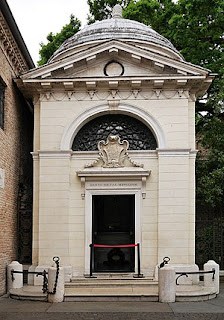Follower of Plato, Dante and Savonarola
 |
| Girolamo Benivieni, pictured as an old man in a painting attributed to Ridolfo Ghirlandaio |
His poem was to influence other writers during the Renaissance and some who came later.
As a member of the Florentine Medici circle, Benivieni was a friend of the Renaissance humanists Ficino, Giovanni Pico della Mirandola and Angelo Poliziano, commonly known as Polician.
Ficino translated Plato’s Symposium in about 1474 and wrote his own commentary on the work.
Benivieni summarised Ficino’s work in the poem De lo amore celeste - Of Heavenly Love - These verses then became the subject of a commentary by Pico della Mirandola.
As a result of all these works, Platonism reached such writers as Pietro Bembo and Baldassare Castiglione and the English poet, Edmund Spencer.
Benivieni later fell under the spell of Girolamo Savonarola, the fiery religious reformer, and he rewrote some of his earlier sensual poetry as a result. He also translated a treatise by Savonarola into Italian, Della semplicità della vita cristiana - On the Simplicity of the Christian life - and he wrote some religious poetry of his own.
| Benivieni's tombstone behind the statue of Savonarola in the Church of San Marco |
Lucrezia de’ Medici supported him in his writing and they shared an interest in the works of Dante Alighieri. In 1506 Benivieni published an edition of Dante’s Divine Comedy with maps by Antonio Manetti and commentaries by Benivieni and Manetti.
He drafted a letter for Lucrezia to send to her brother, Pope Leo X, seeking his assistance in bringing Dante’s body back to Florence from Ravenna where he was buried.
Benivieni also used his connection with Lucrezia to advance his ideas on church reform with her brother, and later with her cousin, Pope Clement VII.
In 1530 he wrote a letter to Pope Clement in defence of Savonarola, seeking to have his reputation restored within the Church.
He died in 1542, a few months before his 90th birthday and was buried in the Church of San Marco in Florence next to his friend, Pico della Mirandola.
 |
| The Church of San Marco in Florence is close to where the fiery priest Girolamo Savonarola lived |
The Church of San Marco, where Girolamo Benivieni and Giovanni Pico della Mirandola are buried together, is in Piazza di San Marco to the north of the Galleria dell’Accademia, which houses Michalangelo’s David. The original tombstone is in Latin. It says: ‘Here lies Giovannni Mirandola; known both at the Tagus and the Ganges and maybe even the antipodes. He died in 1494 and lived for thirty-two years. Girolamo Benivieni, to prevent separate places from disjointing after death the bones of those whose souls were joined by Love while living, provided for this grave where he too is buried. He died in 1542 and lived for eighty-nine years and six months.’ Next to the church is the convent of San Marco, now the Museo Nazionale di San Marco, where Savonarola and the painters, Fra Angelico and Fra Bartolomeo, once lived.
 |
| The tomb of Dante Alighieri adjoins the Basilica of San Francesco in Ravenna |
A tomb built for Dante in the Basilica di Santa Croce in Florence still remains empty. Dante died while living in exile in Ravenna in about 1321. He was buried at the Church of San Pier Maggiore in Ravenna and a tomb was erected there for him in 1483. Florence has made repeated requests for the return of Dante’s remains to the city but Ravenna has always refused.
More reading:
The Bonfire of the Vanities - preacher Savonarola's war on Renaissance 'excesses'
Giovanni Pico della Mirandola – the philosopher who wrote the 'Manifesto of the Renaissance'
Pietro Bembo - the poet and scholar who became Lucrezia Borgia's lover
Also on this day:
1577: The birth of Roman heroine Beatrice Cenci
1778: The birth of the poet and revolutionary Ugo Foscolo
1908: The birth of six-times Italian prime minister Amintore Fanfani
Home

